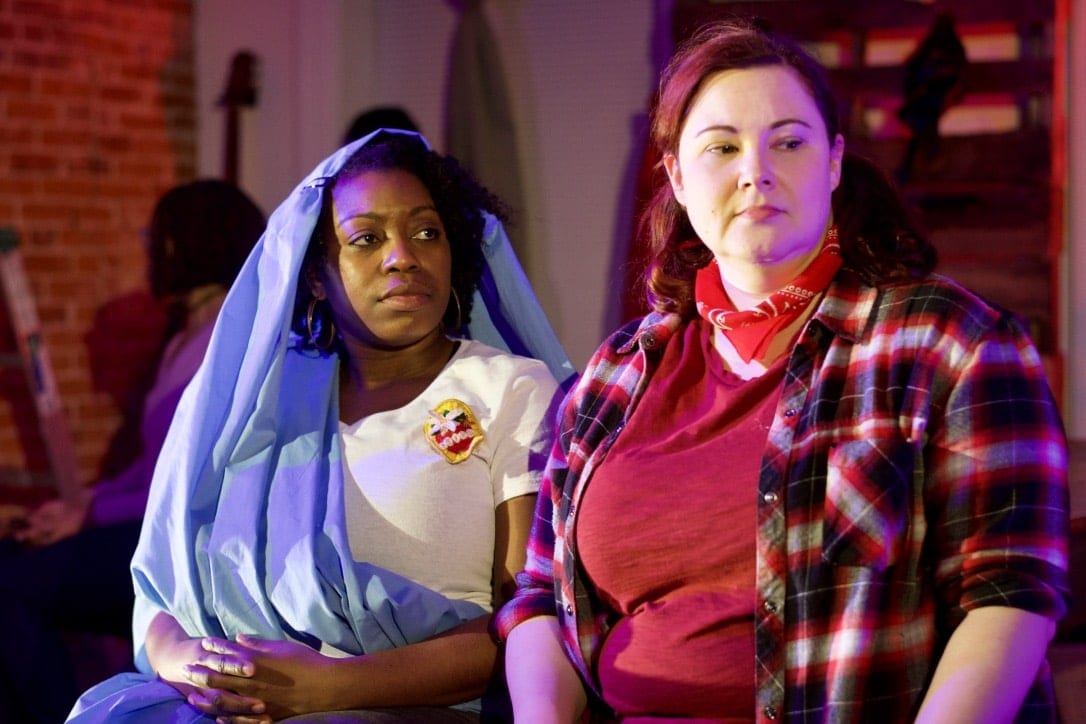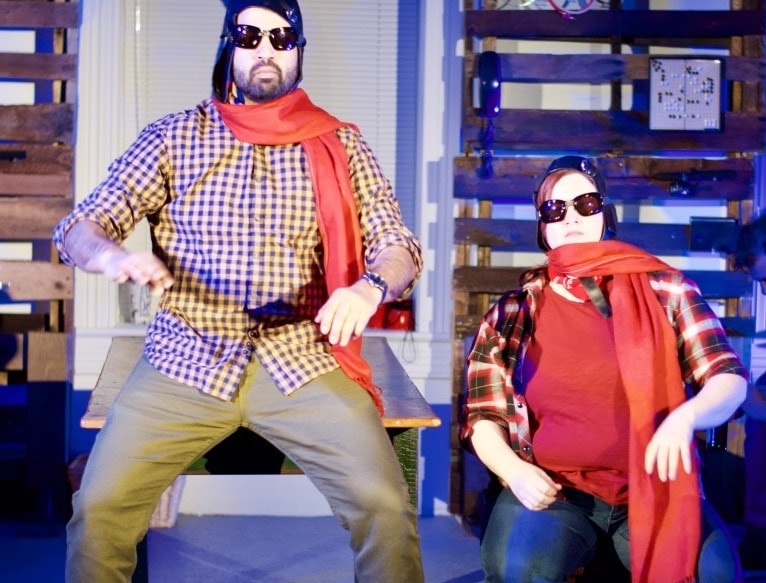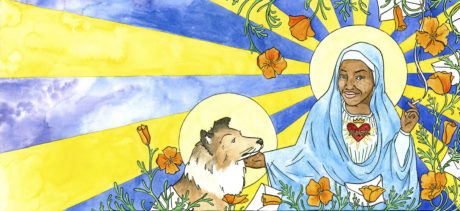There is indeed a dog in this play, aptly named Dog, wryly performed by Karen Lange wearing a plaid shirt, jeans, and neck bandana. At the top of Act One, Dog sings a country-westernish song, “[Taking the] Hard Way Home,” introduced by The Virgin Mary (an amusingly cheeky Dannielle Hutchinson), who wears the requisite pale blue head shawl but who here brashly emcees the show and smokes.

Dog, we learn, has terminal cancer. At the top of Act Two, Dog, still quite hale and hardy, sings “Keep Me in Your Heart [for a While]” as the ensemble goes “Sha-la-la-la-la-la-la-la-la-la-lo.” Later in the act, Lange as still-dying Dog delivers a touching rendition of “[I’m Just a Poor] Wayfaring Stranger.”

During the course of this perplexing patchwork of a play with music, we meet members of Dog’s extended human family, and we hear their loosely related stories in disjointed fragments, some poetic, some dramatic, in shifting nonlinear time frames. There’s a winsome young woman named Juniper (a lively Schuyler Atkins) and her kind boyfriend Timothy (Andy De, who plays a lovely guitar). Dog lives with Juni and Tim, who celebrate what may be Dog’s last birthday. At one point Tim takes Dog on a motorbike road trip. At another, Juni and Tim struggle with whether Dog should be put down.

There’s also Juniper’s divorced parents: her hard-drinking father Atlas (a gruff Erik Harrison), who fishes and bakes bread; and her distracted abstract-painter mother Iris (a dreamy Aubri O’Connor), who daubs at a blue door. Years ago they were fond of each other.
Though there are fractured threads of narrative continuity to infer in this broken-family drama, and some strained relationships to surmise, the playwright leaves the conjecturing to us. Piecing together what’s happening and who’s who to whom becomes our primary engagement with the play. That can work well if it all leads to some big bang of a reveal or emotional payoff for our efforts, but here it ends with a whimper. Dog dies and it’s sad.

The Virgin Mary interjects labels for the miscellany of scenes. Periodically a character “remembers a moment with” another, which we then see enacted: For instance, “Atlas remembers a moment with Iris” in which they cuddle at a lakeshore and skip pebbles over the water. Or a character will have “a dream,” which will then unfold surreally in blue light. Sometimes the announced topics are cogent (“Juniper and Timothy discuss happiness”) and sometimes cryptic (“Atlas asks Dog for advice,” “Tim asks Dog for advice”). As on any meandering path, The Virgin Mary’s signposts are welcome.

Now and then a Big Question With No Answer will pop up. Apropos of not a lot, for instance, Juniper asks, “When is it right to live for me, and when is it right to live for others?” The query goes nowhere. Similarly, Atlas asks, “Why do people leave? Why do dogs run away?” The koan is no sooner considered but it’s forgotten. The script’s meaningfulness is scattershot. Even the random reflections on birthdays seem untethered to any evident through-line of truth.
Lauren Gallup uses minimal lighting equipment to good advantage. Sound Designer Julia Colpitts and Music Captain Karen Lange bring pleasant oldies and goodies into the show, notably “You’ve Got a Friend” and “Blow Me (One Last Kiss).” Costumes by Nina Howe-Goldstein materialize characterizations scarcely sketched in the script. And the set by Julia Colpitts and Mara Sherman serviceably situates Dog’s dog house, Iris’s painting studio, and Atlas’s kitchen table. But that we are nowhere in particular is suggested by oriental throw rugs covering the playing area and, against the upstage wall, two utilitarian wooden palettes holding props that come into play.
Dead Dog’s Bone: A Birthday Play was Veronica Tjioe’s first play and won the Dharma Grace Award in 2012 and the Hollywood Fringe Encore Producer’s Award in 2015. On Tjioe’s website she expresses her artistic taste this way:
I am wild about theatre that involves magical realism, existentialism, clowning, inclusivity, feminism, surprises, accessibility, community…
That list checks most of this work’s discrepant elements, which Director Mara Sherman has ably wrangled.
Whether by accident or intent, Dead Dog’s Bone plays like a long rambling story that is of passing interest in that its details and digressions seem offhandedly inconsequential and its earnest outcome underwhelms. In other words, it plays like a perfect shaggy dog story.
Running Time: One hour 55 minutes, including one intermission.

Dead Dog’s Bone plays through April 14, 2015, presented by Nu Sass Productions performing at Caos on F, 923 F Street NW, Washington, DC. Tickets are available online.




